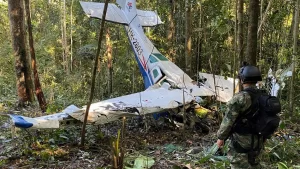
Air travel dangers in Colombia were recently exposed again this past month. According to initial findings from officials’ preliminary investigation, it has been determined that Avianline Charters Flight HK 280, which was transporting seven individuals from Araracuara in Amazonas province to San Jose del Guaviare in Guaviare, experienced an apparent engine failure. Tragically, the aircraft subsequently crashed, resulting in the loss of the pilot, another adult, and the mother of the children on board. The good news is that Colombian authorities have confirmed that a baby and four children were discovered alive in the Amazon forest over two weeks after the plane crash claimed the lives of their mother and the two other individuals. President Gustavo Petro expressed his delight for the country, acknowledging the diligent search efforts carried out by the Military Forces that ultimately led to the successful rescue of the children.
Private Air Travel Safety Concerns In Colombia
Private flying, like any form of aviation, can involve certain risks and challenges. However, it’s important to note that the overall safety of private flying in Colombia has improved significantly in recent years. Colombia has made significant efforts to enhance aviation safety standards, regulatory oversight, and infrastructure development. In the past, Colombia had a reputation for being a more hazardous environment for aviation due to factors such as drug trafficking, civil unrest, and a history of conflict. These conditions could occasionally affect air safety. However, the Colombian government and aviation authorities have taken substantial measures to address these issues and improve safety. Today, private flying in Colombia is regulated by the Colombian Civil Aviation Authority (Aerocivil), which is responsible for overseeing and enforcing safety regulations. Airports and airstrips have undergone improvements in terms of infrastructure, security measures, and navigation aids.
It is essential to note that flying in remote or mountainous areas of Colombia can present additional challenges due to the country’s diverse topography and weather conditions. Pilots need to be well-trained, experienced, and familiar with the specific challenges posed by flying in such regions. To ensure safety, it is advisable to choose reputable operators, pilots, and aircraft, who adhere to international safety standards and have a good track record. Additionally, staying informed about any potential travel advisories or local conditions can help mitigate risks. Overall, while there have been safety concerns in the past, the Colombian aviation industry has made significant strides to improve safety standards, making private flying in Colombia safer than it was previously.
Very High Mountains and Treacherous Terrains
Colombia’s diverse topography, particularly its mountainous regions, can present challenges for private jet operations. Some of the mountains and terrain that can pose issues include:
- Andes Mountains: The Andes Mountains run through Colombia, presenting high altitudes and rugged terrain. The challenging topography can affect flight operations, especially in remote areas with limited infrastructure and navigation aids. The high elevation can require specialized training and aircraft performance considerations.
- Sierra Nevada de Santa Marta: Located on Colombia’s northern coast, the Sierra Nevada de Santa Marta is the world’s highest coastal mountain range. Its steep slopes and unpredictable weather patterns can make flying in the region challenging, particularly for pilots who are unfamiliar with the area.
- Serranía de Baudó: This mountain range runs parallel to Colombia’s Pacific coast. It is characterized by dense rainforests, rugged terrain, and high rainfall. The combination of challenging weather, limited infrastructure, and remote locations can pose difficulties for private jet operations.
- Eastern Cordillera: This mountain range is situated in the eastern part of Colombia, bordering Venezuela. The region features high peaks and deep valleys, which can affect navigation and require pilots to have a good understanding of the local geography.
- Amazon Rainforest: Colombia shares part of the Amazon Rainforest with neighboring countries. Flying in this vast and dense jungle region can be challenging due to limited infrastructure, poor weather conditions, and remote landing areas.
It’s important for pilots operating in these regions to have specialized training, knowledge of the local geography, and experience with mountainous and challenging weather conditions. They need to carefully plan flights, consider performance limitations at high altitudes, and be prepared for potential weather changes. For example, Bogotá, the capital city of Colombia, is located in the Andean region of the country. It is situated at an altitude of approximately 2,640 meters (8,660 feet) above sea level. The high altitude of Bogotá is one of its distinguishing features and can have an impact on the unique dangers of flying there.
Quality Of The Private Aircraft In Colombia
The quality of private aircraft in Colombia can vary depending on various factors, such as the age of the aircraft, maintenance practices, and the operator’s standards. However, Colombia has a growing aviation industry, and there are reputable operators that maintain high-quality private aircraft. Many private jet operators in Colombia adhere to international safety standards and regulations, ensuring that their aircraft undergo regular inspections, maintenance, and servicing.
When selecting a private aircraft provider in Colombia, it is crucial to choose a reputable and well-established operator. Consider factors such as their safety record, fleet age, maintenance practices, and certifications. Reputable operators will prioritize safety, have experienced and qualified pilots, and invest in keeping their aircraft in optimal condition. Additionally, it is advisable to consult with aviation professionals or seek recommendations from trusted sources to ensure you select a reliable and high-quality private aircraft operator in Colombia.
Until Next Week, remember to Be Social, Fly Private!
